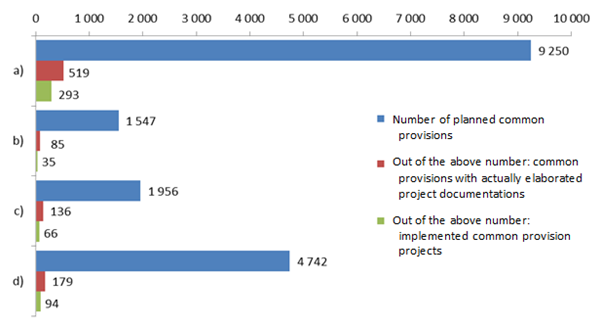Land consolidation delayed by uneven drawing from EU funds
PRESS RELEASE on Audit No. 14/40 – June 1, 2015
The Supreme Audit Office (SAO) scrutinized funds, which were used for remittance costs of land consolidation – the process of rearrangement of land parcels and their ownership – and for land improvement projects. Among other financial sources, funds were provided by the Ministry of Agriculture from the Rural Development Programme. The audited period was from 2011 to 2013 and where relevant, the preceding and following years were also scrutinized. Within the period 2007–2014, the Ministry of Agriculture spent CZK 13,000 million on land consolidation and land improvement projects. Auditors revealed that it was not possible to draw subsidies from EU proportionately, the annual investments to land consolidation and land improvement projects ranged from CZK 1,200 to 2,100 million. Funds provided from the Rural Development Programme made 34 % of the total expenditures for land consolidation and land improvement projects.
Auditors concluded that the actual implementation processes related to planned land consolidation and land improvement projects took long time in the Czech Republic. Since 1995, only 9 % of provisions have been implemented in previously consolidated cadastre areas; the provisions aimed at making lands accessible and implementing anti-erosion provisions, water management provisions, and provisions for environmental protection and development. Considering the present progress, it could take several decades (!) to complete all planned provisions.
For example, only 7 % of planned anti-erosion provisions have been implemented since 1995. In the Czech Republic, some 50 % of arable lands are threatened by floods and nearly 10 % by wind erosion. Most threatened lands are not systematically protected and arable lands are shrinking.
The Rural Development Programme mainly aimed at improving the competitiveness of the agricultural and forestry sector, conserving or developing the environment, and improving the quality of life in rural areas. Among the reasons of the low take-up rate of funds in the area of land consolidation and land improvement were differences between costs mentioned in the decision to allocate subsidies and the prices from competitions, which were sometimes close to 50 % of estimated prices. On average, the information about the different prices got to the State Agricultural Intervention Fund after 241 days. During the interval, the Fund had to keep the allocation assigned and could not provide subsidies to other projects. The Ministry of Agriculture failed to stipulate that the beneficiaries should inform the Ministry about the contracted prices without delay. It was as late as in 2014, when the Ministry changed the regulations.
Auditor pointed out that it was difficult to assess the effects of implemented land consolidation and land improvement projects. Measuring the achievements towards the long-term Programme’s objectives is problematic. The Ministry of Agriculture set criteria for continuous evaluation of land consolidation and land improvement projects but the chosen criteria did not show how the planned provisions had been implemented or the effectiveness of land improvement processes. According to the current legislation, the Ministry of Agriculture or the Lands Administration Office cannot require that the planned anti-erosion provisions are implemented. Sanctions for noncompliance are administered by the Ministry of the Environment but it does not cooperate with the Ministry of Agriculture in that area.
Figure 1: Planned, projected, and implemented provisions planned for the period from 2003 to 2014 (data collected in five various regions)

Plans of common provisions include:
a) Provisions for making lands accessible
b) Anti-erosion provisions
c) Water management provisions
d) Provisions for environmental protection and development
Communication Department
Supreme Audit Office